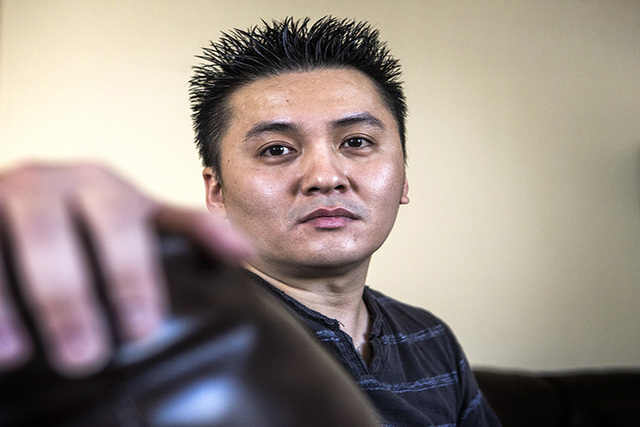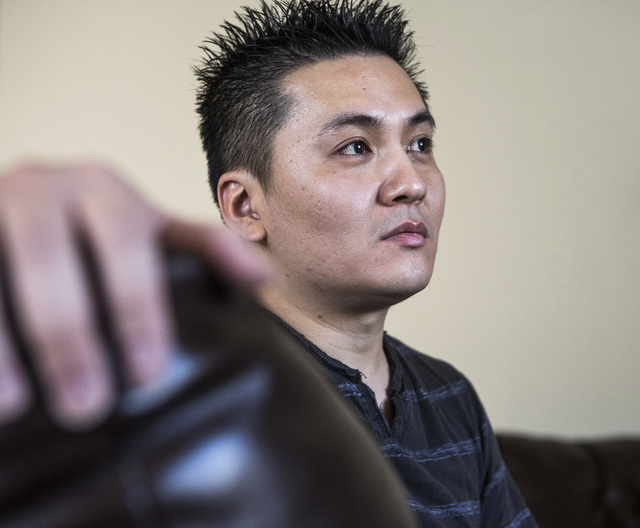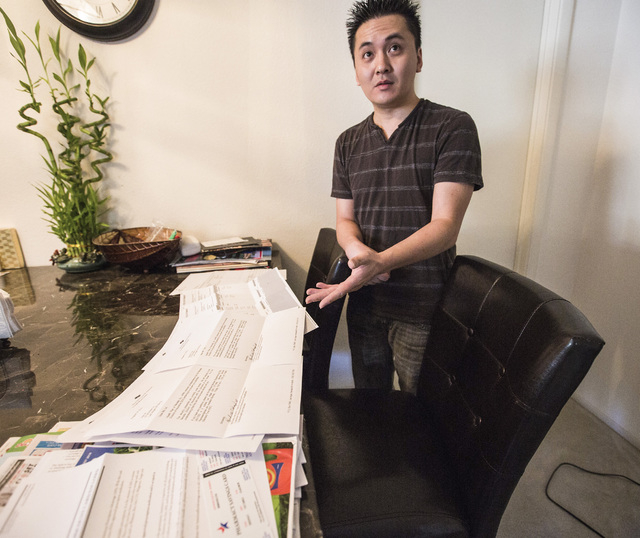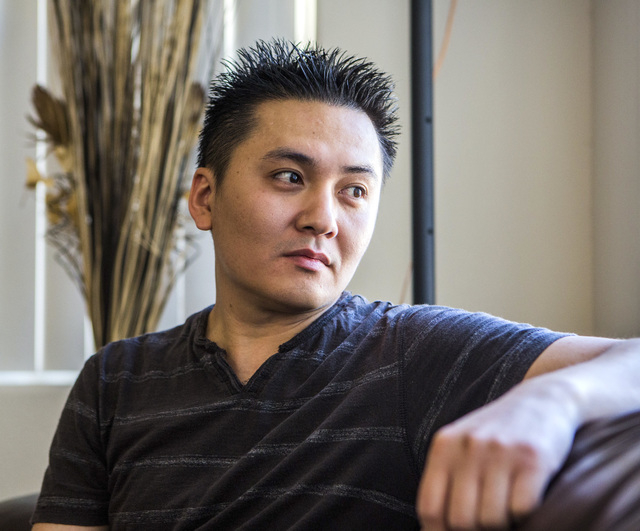Lost state insurance payments leave many exposed
Bobby Tran and Ha Le paid nearly $7,000 in insurance premiums to Nevada Health Link through August and had nothing to show but $3,000 in medical bills.
The couple, Las Vegas manicurists, spent $573 a month starting Jan. 1 on platinum coverage through the state’s health insurance exchange, created under the Affordable Care Act to sell federally subsidized plans.
Inexplicably, the payments never made it to the couple’s insurer, Health Plan of Nevada. The couple racked up thousands in medical bills before learning there was a problem.
“It’s so stressful. If I get into an accident or something, I’m not covered,” Tran said Friday. “I have to find ways to resolve this. I know I’m paying every month for nothing. It’s very frustrating.”
Insurance brokers say dozens of other consumers are enduring payment problems — and thousands more yet to use their coverage could face Tran’s trouble if they get sick or injured.
Las Vegas insurance broker Pat Casale estimates that 10,000 of the exchange’s 38,000 enrollees have had payment struggles, including 60 of the 90 clients he signed up. Today, about 3,800 health link buyers statewide have unresolved issues, he said. Some don’t know yet that they have coverage issues. One of Casale’s clients went to the doctor two weeks ago and only then learned he had no policy.
That’s why brokers say exchange customers need to confirm they are covered.
“You have to check it literally every week from your effective date,” said Las Vegas broker Lou Cila. “And you have to be pushy. Tell (Nevada Health Link) that you want someone on the phone to confirm to you that your carrier will have your information within 24 hours, if they don’t have it already.”
But Tran and Le say they were plenty persistent. They illustrate the maddening plight of the unknowingly uninsured — maddening for consumers because their case shows how easy it is to fix problems that are not being addressed.
BILLS POURING IN
The couple signed up for a plan ahead of the Dec. 15 deadline for coverage effective Jan. 1, and paid their first premium in January. They didn’t worry when their ID cards didn’t come until February — Tran said he understood there were computer glitches.
What he didn’t know was that Xerox, the Nevada Health Link website contractor and the party responsible for forwarding payments to carriers, was apparently not sending his money to Health Plan of Nevada.
After 90 days without payment, consumers lose their coverage, so Health Plan of Nevada dropped Tran and Le after April 30.
Tran and Le didn’t get a cancellation notice until July — two months after they arranged for medical procedures, lab tests and medications they thought were covered.
The bills started to pour in about five weeks ago.
Nevada Health Link told Tran he looked current in the system, but Health Plan of Nevada told him it hadn’t been receiving his payments. So Tran traipsed over to the insurer’s Tenaya Way offices with bank statements and sent a letter to the state Division of Insurance. The state’s response: It was waiting for a response from Health Plan of Nevada.
There was still no resolution by Friday. Nor could the exchange say when his issue would be fixed.
But Health Plan of Nevada and the exchange had no trouble working things out Monday afternoon, within three hours of a Review-Journal call about Tran’s case.
“We appreciate Mr. and Mrs. Tran’s patience as we worked with the exchange to resolve this matter and ensure they are provided with ongoing access to health care services,” Health Plan of Nevada parent UnitedHealthcare said in a statement. “This issue, which continues to occur, was a result of us not receiving or being provided all the necessary information and payments in a timely manner.”
The exchange was still reviewing Tran’s case late Tuesday, said spokesman Tyler Klimas, who said “each enrollment issue is different.”
“We are working hard to identify and help solve these issues so consumers can focus on getting the care they need. There will continue to be collaboration between the exchange, Xerox and carriers in these efforts,” Klimas said.
‘HUGE DISCONNECT’
It’s unlikely Tran and Le will be the last exchange customers reporting missed payments.
On Monday — a due date for premium payments — some consumers discovered the “make payment” button had disappeared from Nevada Health Link’s website.
Brad Zucroff of Las Vegas said a customer-service representative told him at 5:45 p.m. Monday there was “no ETA for a fix.” Tuesday morning, Zucroff said, there was still no way to make a payment online or by phone.
Zucroff said he was told he could mail a check, but he wouldn’t get a receipt. He definitely wants a record: It took seven months to iron out his effective-coverage date, which the exchange listed incorrectly on his paperwork and fixed in its system just last week. His insurer still doesn’t have the right information, though, he said.
Klimas said Tuesday the exchange was unaware of any new problems with the online payment portal.
“We encourage any enrollee who might be experiencing difficulties paying online to call a customer service representative for assistance or use one of the other payment options available,” he said.
Xerox declined to comment on Tran’s case, citing patient-privacy laws, but brokers say the payment trip-ups begin and end with the company’s computers.
“We know there’s a huge disconnect in the software between the client, the carrier, the agent and the money,” said Dwight Mazzone, a broker and exchange consumer-affairs committee member. “They can’t seem to put everything in the right bucket that says, ‘Here’s the application, here’s the premium, let’s forward it to the insurer and have them issue the case.’ We don’t know where they send payments, or why they’re not sending payments.”
Added Casale: “Xerox can show payments are received, but they’re not sending everything over to the carriers to be effectuated properly. If nothing is going over to the carrier, then the carrier has no way to verify the member. So the member is trapped in cyberspace.”
MORE TO COME
That trap should begin releasing consumers in November. That’s when the state exchange, which fired Xerox effective at year’s end, begins borrowing the sign-up system of the federal healthcare.gov exchange. After the changeover, insurers will bill and collect payments directly.
Until then, consumers should verify coverage, and the exchange and carriers should meet face-to-face to reconcile questionable accounts, Mazzone said.
And while it might be “moral” to halt exchange plan cancellations until payment problems are patched, as some brokers have suggested, it’s not practical, Mazzone said. Insurers have no choice but to cancel coverage if they’re not getting paid. Instead, he said, Xerox should be held liable for medical expenses of people left uncovered because of system flaws.
Tran doesn’t care about the specifics. Just fix it, he said.
“They should do their job. Pay Health Plan of Nevada so consumers don’t become victims,” Tran said Friday. “Do a better communication job with Health Plan of Nevada. Don’t just email me and tell me everything is fine. I think this is a common problem, but no one can do anything about it.”
Contact reporter Jennifer Robison at 702-380-4512 or jrobison@reviewjournal.com. Follow @J_Robison1 on Twitter.































